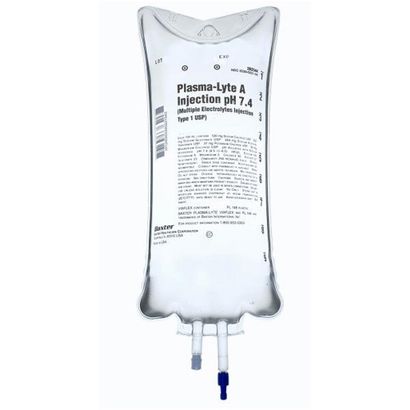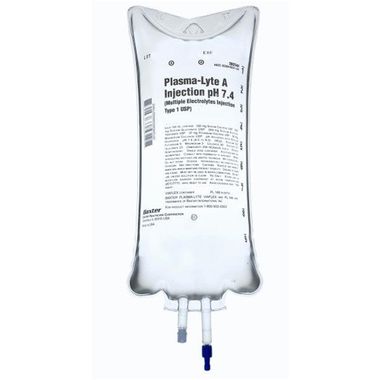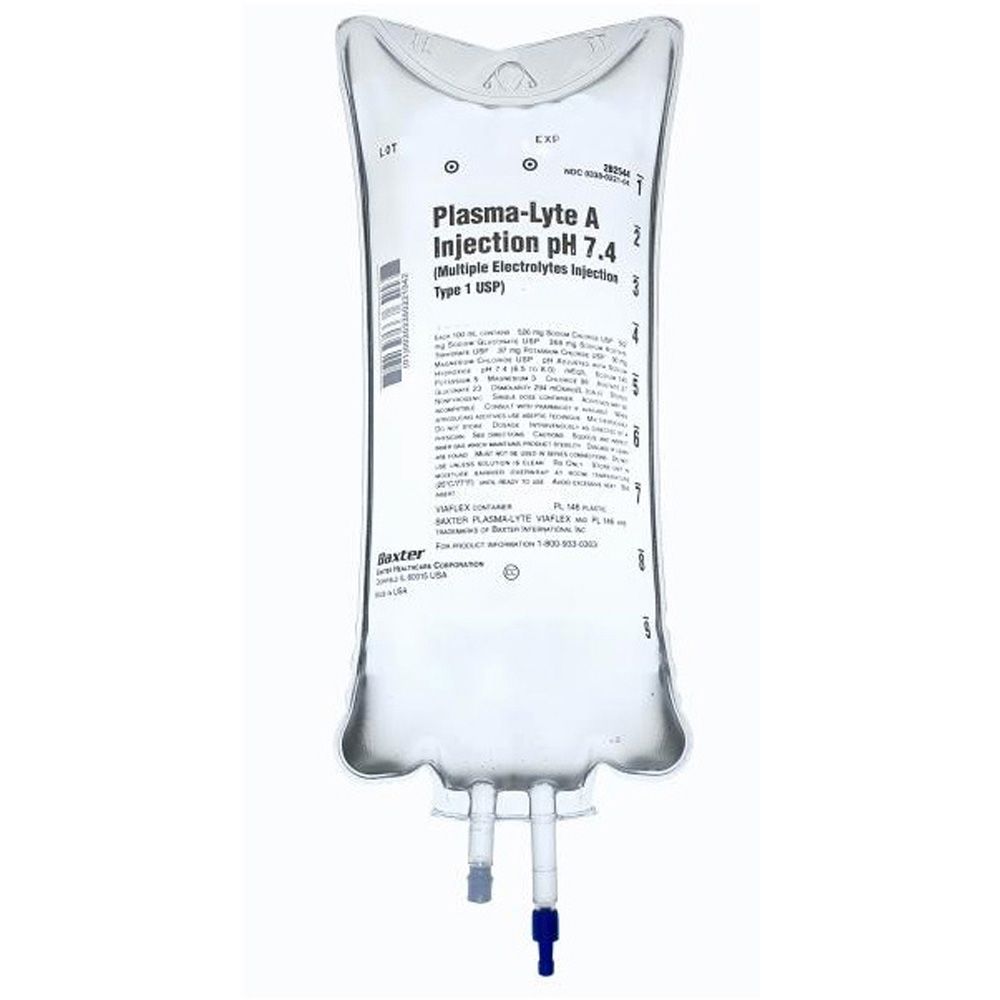Sitewide SALE! GET 15% Off! Use Code EPX15 *

PlasmaLyte A Inj 7.4Ph 5000ml
- Notice
- Description
- Directions
- FAQ
- Reviews
Notices
Description
PlasmaLyte A is an injectable liquid that contains sodium, potassium, and other electrolytes. It is used in situations where rehydration is necessary. Examples of this include shock, decreased oral intake of fluid and food, illness such as kidney disease, and other problems. PlasmaLyte A is administered as an injection either under the skin (subcutaneously) or in the vein (intravenously) as directed by your veterinarian. This solution can be given at home as necessary and your veterinarian can teach you the proper administration technique.
Key Features
- Can be helpful in the treatment of multiple ailments where rehydration is necessary.
- Helps restores fluid balance when your pet loses fluid such as in times of dehydration, shock, and certain diseases such as kidney failure.
- Your veterinarian can teach you how to administer PlasmaLyte A at home if needed.
- Can be used under the skin (subcutaneously) or in the vein (intravenously).
- Economical.
- Can be used in multiple species including dogs and cats.
How It Works
It works to restore electrolytes (sodium, chloride, potassium, etc.) in situations where there is a loss of fluid. PlasmaLyte A rehydrates the body and helps to maintain proper hydration. Hydration is necessary for normal body function. Electrolyte balance is important for certain actions including muscle contraction and nerve activity.
Indications
This solution is indicated for use in adults and pediatric patients as a source of electrolytes and water for hydration.
Directions
PlasmaLyte A is an injectable liquid that can be given under the skin (subcutaneously) or in the vein (intravenously) as prescribed by your veterinarian. Your veterinarian will determine the proper amount of fluid and route administration that is best for your pet so always follow his/her instructions. If you have trouble giving this medication or if you do not understand the directions, contact your veterinarian. If you forget to give a dose, try to give it as soon as you remember but do not give two doses at once. Your veterinarian may instruct you and teach you how to give PlasmaLyte A at home. For proper administration, you will also need a fluid drip set and a needle in addition to the bag of fluids. Your veterinarian will let you know what equipment is necessary. In general, PlasmaLyte A can be administered as follows:
- Remove the fluid bag and fluid drip set from their protective packaging.
- Close the line lock in the middle of the fluid tubing by moving the roller so that it squeezes the tubing. The lock on a new fluid set is usually set to the open position.
- The top end of the fluid set has a large, pointed end with a protective cap. Remove this cap, but do not allow it to become contaminated. MAKE SURE IT DOES NOT TOUCH ANYTHING.
- Pull off the covering from the exit port on the bottom end of the fluid bag and push the pointed end of the fluid set into the open hole of the fluid bag. Make sure it is seated firmly or it can leak.
- Squeeze and release the bulb at the top of the drip set until the bulb chamber is about half full with fluid.
- Open the line lock and/or roller on the tubing and then hold or suspend the fluid bag. Fill the fluid line with fluid from the bag until it runs the entire length of the tubing. Be sure that all large air bubbles run out of the tubing.
- After the fluid line has been primed, close the lock and move the roller down.
- Twist the needle on to the end of the fluid line as clean as possible. Do not contaminate the open end.
- Insert the needle and deliver fluid as directed by your veterinarian. Your veterinarian can answer any questions you may have regarding the use of PlasmaLyte A. This medication should only be given to the pet for which it was prescribed. Needles and drip sets are also available only when prescribed by a veterinarian.
| PlasmaLyte A Injection Dosage for Dogs | |
|---|---|
| Weight | Dosage |
| All weights | As directed by a veterinarian. Dosage is dependent upon the age, weight and clinical condition of your pet, as well as laboratory determinations. Parenteral drug products should be inspected visually for particulate matter and discoloration prior to administration whenever solution and container permit. |
| PlasmaLyte A Injection Dosage for Cats | |
| Weight | Dosage |
| All weights | As directed by a veterinarian. Dosage is dependent upon the age, weight and clinical condition of your pet, as well as laboratory determinations. Parenteral drug products should be inspected visually for particulate matter and discoloration prior to administration whenever solution and container permit. |
| PlasmaLyte A Injection Dosage for Horses | |
| Weight | Dosage |
| All weights | As directed by a veterinarian. Dosage is dependent upon the age, weight and clinical condition of your pet, as well as laboratory determinations. Parenteral drug products should be inspected visually for particulate matter and discoloration prior to administration whenever solution and container permit. |
Caution:
Do not administer to horses by intraperitoneal injection.PlasmaLyte A Injection should be used with great care, if at all, in pets with congestive heart failure, severe renal insufficiency, and in clinical states in which there exists edema with sodium retention.PlasmaLyte A Injection should be used with great care, if at all, in pets with hyperkalemia, severe renal failure, and in conditions in which potassium retention is present.PlasmaLyte A Injection should be used with great care in pets with metabolic or respiratory alkalosis. The administration of lactate ions should be done with great care in those conditions in which there is an increased level or an impaired utilization of these ions, such as severe hepatic insufficiency.In pets with diminished renal function, administration of PlasmaLyte A Injection may result in sodium or potassium retention. PlasmaLyte A Injection is not for use in the treatment of lactic acidosis.
Precautions:
This medication should be used cautiously in animals with heart disease, obstruction of the urinary tract, kidney disease, as this may lead to overhydration.
This item does not come with the tubing and needles needed for administration. Tubing and needles must be purchased separately.
Possible Side Effects:
Possible side effects may include febrile response, infection at the site of injection, venous thrombosis or phlebitis extending from the site of injection, extravasation, and hypervolemia. If an adverse reaction does occur, discontinue the infusion, evaluate the pet, institute appropriate therapeutic countermeasures, and save the remainder of the fluid for examination if deemed necessary.
Storage:
Store at temperatures between 68° - 77°F.


